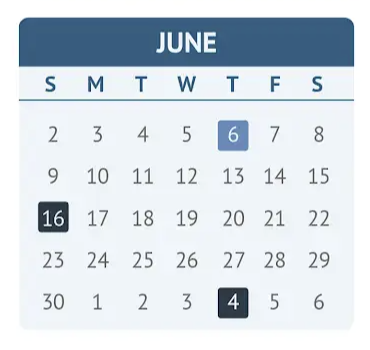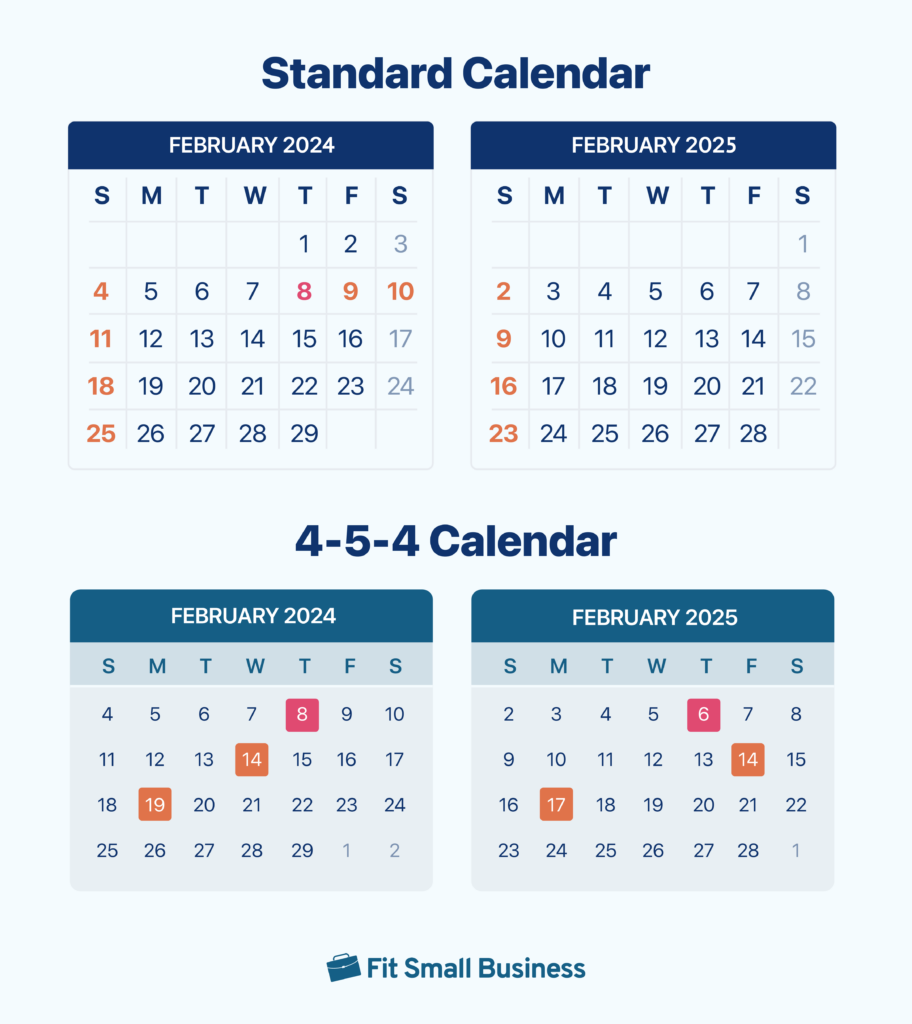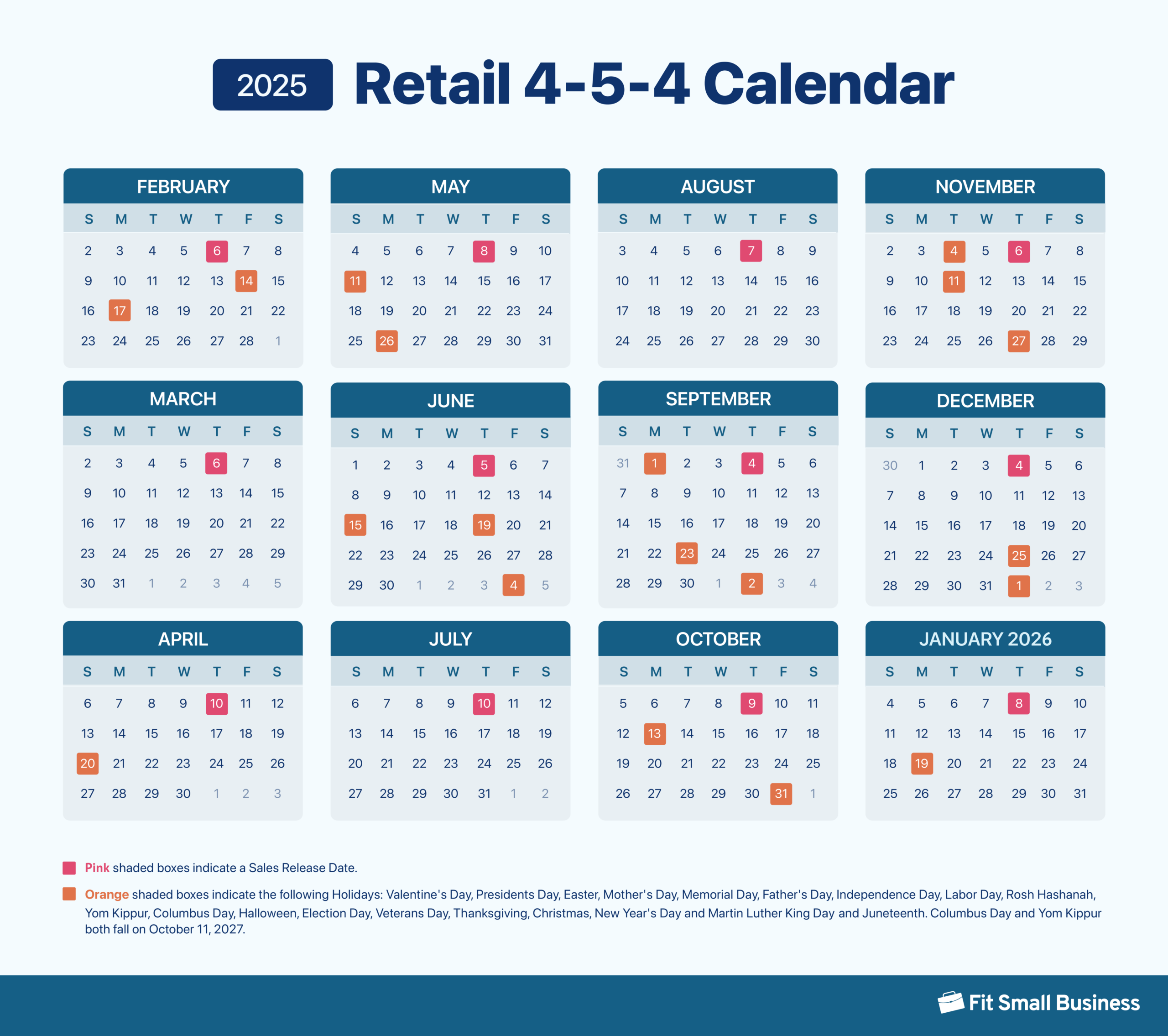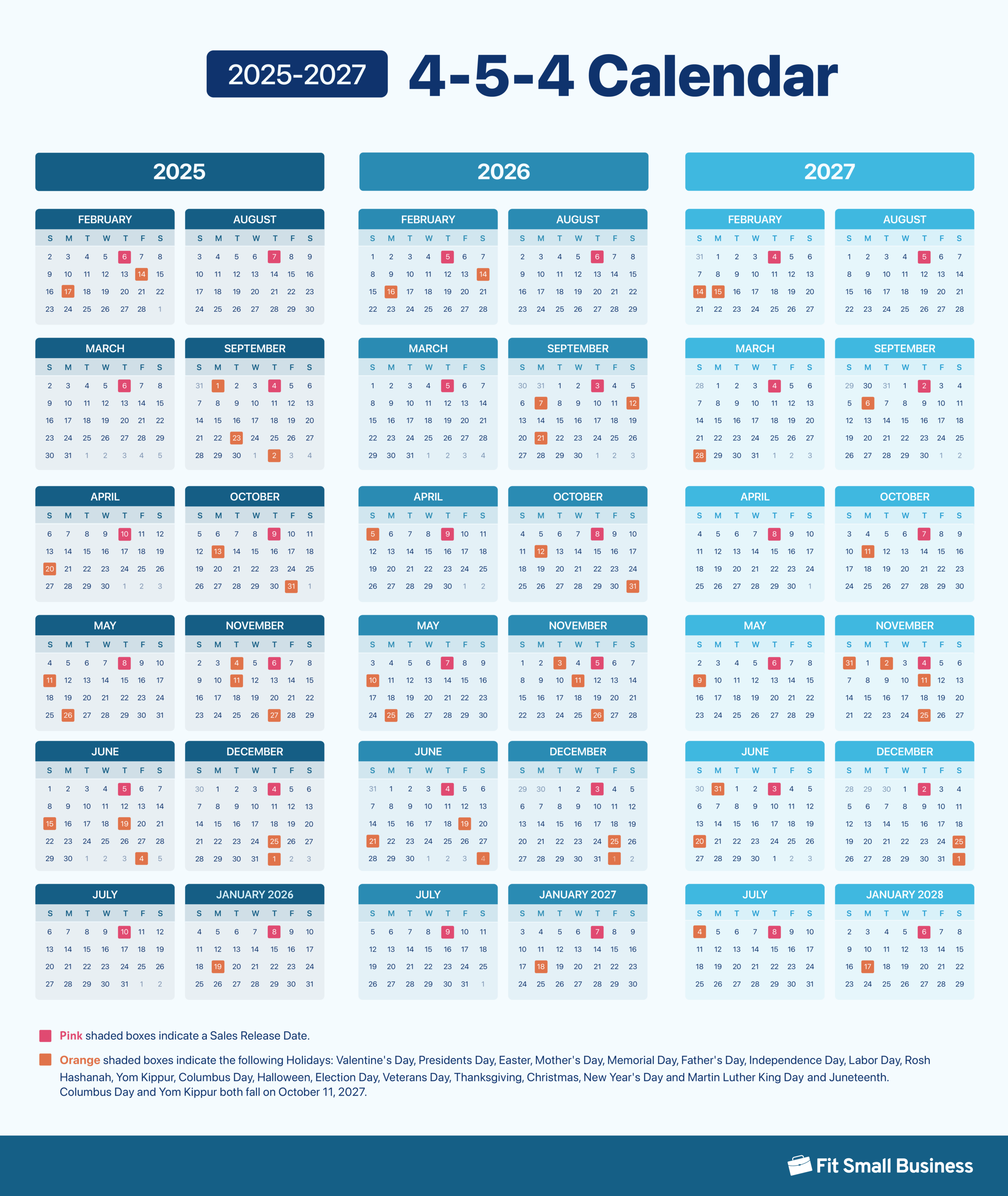Download and use our free 4-5-4 calendars to compare year-over-year retail sales. Read more about how to use them in our guide below.
4-5-4 Retail Calendar: How to Use + Free 2025 Download
This article is part of a larger series on Retail Management.
2025 4-5-4 Retail Calendar Download
2025-2027 4-5-4 Retail Calendar Download
A 4-5-4 calendar is a retail calendar that helps businesses accurately compare sales figures between years on a granular level by starting the fiscal year in February and dividing the year into months of 4 weeks, 5 weeks, and 4 weeks, with each week starting on Sunday and ending on Saturday.
This 454 retail calendar structure allows for a more precise comparison of sales data between years by ensuring an equal number of weekends and a more even number of holidays in each comparable month. It also enables a more direct comparison between the days of the week—comparing Mondays to Mondays and Saturdays to Saturdays across different years.
Understanding the 4-5-4 Structure
A 4-5-4 calendar differs from the standard calendar by organizing the business year into more comparable periods of exactly 4-week and 5-week months. This setup ensures a steady number of weekends and weekdays each month, which then allows businesses to easily compare sales data from year to year, plan budgets, and compare holiday sales and promotions more effectively.

An example of a month’s view in a 4-5-4 retail calendar.
Note:
- Sales Releases (highlighted with light blue boxes in the calendar above): The Census Bureau usually releases these official reports on the first Thursday of every month, though they can be issued more frequently at times. They measure the fluctuations in the total value of sales at retail stores, serving as a primary indicator of consumer spending habits.
- The 4-5-4 calendar is divided into 52 weeks of seven days each, or 364 days in total. This leaves an extra day to be accounted for each year (in addition to extra days from leap years), making it necessary to add a 53rd week to the end of the retail calendar for reporting purposes. Roughly every five to six years, we get a 53-week year, as we saw in 2006, 2012, 2017, and 2023.
How to Use a Retail 4-5-4 Calendar
The 4-5-4 retail calendar is an essential tool for retailers aiming to track and compare their sales performance accurately. Here’s a basic guide on how to use a retail federation calendar:
Sales Comparison
The most common use of the 4-5-4 calendar is comparing sales between years, as 4-5-4 calendars allow you to compare your business’ sales performance accurately on a variety of levels, from annual down to daily sales.
- Month-to-month comparisons: For example, you could compare sales numbers from February of this year to February of last year. Due to the 4-5-4 structure, the months of February from both years will contain the same number of weekends, weekdays, and holidays, allowing your YoY monthly comparison to be far more comparable and meaningful than if you had used a traditional calendar.
- Comparing specific days: You can also use your 4-5-4 calendar to compare sales from individual, specific days. As you can see below, the first day of the February 2024 calendar is the 4th, and the first day of the February 2025 calendar is the 2nd. Since both of these days were Sundays in their respective years, the comparison should be apt.
- Quarterly comparisons: Each quarter on the 4-5-4 calendar contains two 4-week months and one 5-week month. This allows you to accurately measure quarterly growth within a fiscal year as well as compare quarters or seasons year over year.
As you go through each day of 2025 and set sales goals, you will refer back to your 2024 4-5-4 calendar to see what days you should be comparing from the previous year. But, how exactly do you determine which days to compare with each other?
Taking the image below, if you are setting a sales goal for the first day of February 2025, you would refer back to the first day of February 2024. In this case, the first day of February for 2025 is February 2nd, and the first day of February for 2024 was February 4th. From there, you can take your sales total from February 4, 2024, and use it to set your sales goal for February 2, 2025.

The YoY comparison for the first day of February using the 4-5-4 calendar allows you to compare a Sunday to a Sunday. If you were to use a standard calendar to compare the first day of February, you would be comparing a Saturday (2025) with a Thursday (2024).
The idea here is that the previous year’s sales are a good benchmark for your performance the following year and offer a good point of comparison. Most businesses aim to grow year-over-year, so you should strive not just to meet last year’s sales number but to surpass it.
For example, you can take your sales figures from the year before and increase them by 10% to set your current-year sales goals. So, if your store made $1,000 on February 4, 2024, your sales goal for February 2, 2025, would be $1,100.
Promotions & Marketing Planning
The 4-5-4 calendar is also useful in conjunction with your retail marketing calendar for planning sales promotions or marketing campaigns. Since the 4-5-4 calendar allows for comparing like days (Mondays with Mondays, for instance), you can gain insights about which days of the week perform best for particular promotions—thus informing future campaign planning.
Plus, by better understanding the sales trends of specific periods (such as certain weeks, months, or quarters), you can schedule promotions to boost sales during historically slower times. Similarly, you can capitalize on traditionally busy times by planning major promotions or campaigns during peak periods.
You should note if you have an event in a previous year and do not repeat it during the same period the following year (or vice versa). Event days typically see higher sales numbers, so they can skew YoY comparisons if you don’t follow the same event schedule.
Related:
Inventory Management & Merchandising
The 4-5-4 calendar can also help optimize your merchandising strategy and open-to-buy planning (a system for managing retail inventory).
One of the key benefits of using a 4-5-4 retail calendar is that it offers a predictable structure for assessing and responding to buying patterns. By breaking the year down into consistent periods that contain the same number of weekends and weekdays (along with more comparable holidays), you can better predict when customers are most likely to make purchases. This lets you strategically adjust your inventory levels to meet seasonal demand.
It also allows you to more accurately measure the performance of specific product lines or categories over time. This can help with merchandising efforts and provide key insights into the best timing for introducing new products or phasing out old ones.
Read more:
- How to Budget a Retail Business in 6 Steps + Free Templates
- What Is Inventory Planning? Guide for Retailers
- What Is Merchandise Planning? Guide for Retailers
Pros & Cons of 4-5-4 Retail Calendars
The 4-5-4 calendar has a lot to offer retailers, but there are a few drawbacks as well. But at the end of the day, the pros that come with using a retail calendar outweigh the cons—which is why it’s an industry standard.
Being able to keep your business on track with apt comparisons of your sales data is pivotal for keeping your business on an upward trajectory.
| PROS | CONS |
|---|---|
| Ensures fair comparison of sales figures between years | Different month lengths make comparing month-over-month data inaccurate |
| Enables realistic goal-setting | Some months will see two sets of “monthly” payments (e.g., rent, utilities, and payroll) |
| Keeps your business on track with measured, day-by-day incremental increases | Monthly budget fluctuations due to variable lengths |
| Provides a strong understanding of the performance and expectations you should have | 53-week year every five to seven years gives one year an extra week of revenue |
| Aids in marketing, merchandising, and inventory planning | Discrepancies in YoY calendars can create confusion and comparison challenges |
Frequently Asked Questions (FAQs)
Click through the questions below to get answers to some of your most frequently asked 4-5-4 retail calendar questions.
A retail calendar is a calendar that uses a unique fiscal year structure that allows retailers to make more apt comparisons in their sales and overall performance year-over-year. There are several types including 4-5-4 and 4-4-5 retail calendars.
Yes, it can. It is usually used, together with the 4-5-5 calendar in the hospitality, publishing, and manufacturing industries.
The National Retail Federation addresses the 53-week year by adding a week to the fiscal calendar every five to six years. Roughly every 5-6 years, we get a 53-week year, as we saw in 2006, 2012, 2017, and 2023.
Bottom Line
A 4-5-4 retail calendar makes it easier to compare sales year-over-year, plan, and set reasonable goals. It better aligns holidays and ensures the same number of non-weekdays in comparable months. Our free 2025 4-5-4 retail calendar download can help you get your business on the right track.

